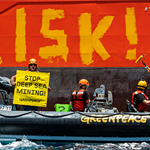Mining The Moon for Helium-3 – BBC Documentary
Energy Disrupter
The Moon has long been the target of space exploration. From humanitiys very first voyages into space, the Moon has been an obvious destination to reach. Long held as a source of beauty in the night sky we have only recently learned how precious the Moon to life on Earth as well as if we are to ever expand our civilization beyond Earth.
The Moon holds vast resources crucial for developing new technologies and expanding our scientific knowledge as we venture into space. One of these materials is a true “unobtainium” : Helium-3, an isotope of Helium which is extremely rare on the Earth and one which may hold the key to an energy source greater than all fossil fuels and renewable combined and one which produces no greenhouse gases or mountains of radioactive waste.
Helium-3 is a fuel source for an aneutronic fusion reaction with deuterium, which releases no harmful neutrons decreasing the hazard of nuclear fusion considerably. Deuterium is common on the earth, (158 ppm in seawater), however Helium-3 is scarce on the Earth and can only be made by nuclear fission in small amounts.
4 Billion years of solar wind bombardment has left lunar soil one of the richest sources in the solar system of Helium-3, although the gas giant planets such as Jupiter and Saturn are richer, having absorbed more Helium-3 from the nebula that formed the solar system.
The far, or “dark”, side of the moon is particularly rich in Helium-3 as this side of the moon always faces away from the earth meaning that it has had a steady buildup of the stable He-3 isotope for 4 billion years. The near side also has significant quantities, however it is decreased as the earth’s magnetic field and the earth itself would have decreased the particle flux from the sun reaching the moon.
Hence, people who appreciate the moon for its natural beauty need not panic as it may be convenient to mine the far side of the moon if we chose to mine it at all, leaving the natural beauty of the near side alone. As we never see the far side, it will be unnoticeable from the earth that we are mining the moon at all as will not have to make track lines over any any natural features of the moon as seen from earth.
Even so it would take thousands of years to make any significant changes to the moon.
Craters could even be swept of external regolith and smoothed to make giant radio telescopes, as the Earth’s radio noise and atmosphere make certain radio frequencies inaccessible from earth-based observatories but this would not be a problem on the far side of the moon. Optical observatories could also be built on the moon to sizes and resolutions impossible to achieve on earth and even on earth orbit, as the low gravity, lack of atmosphere and lack of glare from light reflected off the earth itself would mean giant, stable mirrors could be built and observe a truly dark and clear sky. Moreover the deepest craters are found on the far side of the moon. Since water can only be found in significant quantities on the moon in deep craters where it can remain semi stable inside of rocks most of the water may be on the far side of the moon, or at least at the poles, embedded in the lunar soil in such craters.
Therefore the economic and scientific centers of the moon may be on the side which never faces the earth!
Helium-3 is a valuable resource and supplies on earth are always low. It can be created on the earth as a decay product of Hydrogen-3 (Tritium) or when Lithium is bombarded with neutrons under certain cross-sections. At a price of 3 billion US dollars per tonne, mining the moon for this resource is highly economical. About 20 tonnes of helium-3, which would fill a single oil truck, would power the US for a whole year.
Aside from a fuel source for fusion, Helium-3 is also used in neutron spin polarization spectroscopy which measures the magnetic properties of nanomaterials, such as superconductors. This is due to unique spin-dependent absorption cross-section of Helium-3. The isotope is also used in cryogenics to achieve nanokelvin temperatures in dilution refrigerators making it an crucial material for science and industry.
Helium-3 reserves are critically low worldwide and unless there are efforts by the nuclear industry on earth to replenish them by producing more tritium then the moon seems to be the best option economically to harvest this precious resource. The fact that, once liquefied, it can be easily transported in high densities and is valuable enough that a space-shuttle sized cargo would be worth $30 Billion. A continuous mining operation on the lunar surface would guarantee huge revenues for whatever nation sets up the first mining operations there, along with even greater revenues to the nation that perfects the physics and engineering to use it as fusion fuel.
Original source: https://www.solrenen.com/2020/09/27/mining-the-moon-for-helium-3-bbc-documentary/









